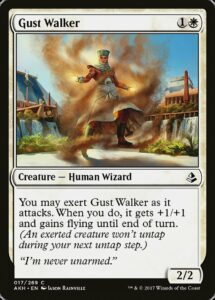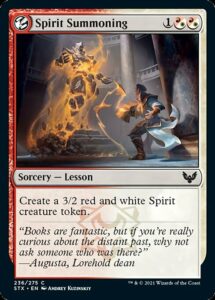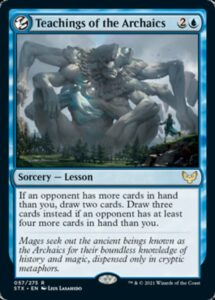Strixhaven is out, and it’s one of the more innovative sets we’ve seen in a while. The entire set is built around filling your deck with spells, and Learn+Lessons are the glue that enables you to overfill your deck with spells that you would otherwise not play (or play and struggle with a dearth of creatures).
We discussed Lessons and Learn last week. We already know that Learn is worth about 1 mana (half as much as adding “draw a card” to a card), that Lessons are overcosted to compensate for Learn being a cheap and for them being tutorable, and that all Lessons are sorcery speed so that opponents aren’t forced to play around combat-relevant instants. But conjecture is one thing—actual play experience is another. How do Lessons stack up?
Learning works, but timing is key
Thus far, I’ve always been happy having access to Lessons but never felt like I absolutely needed them. Strixhaven seems a fairly slow set, so there’s plenty of time to Learn and apply your Lessons without every opponent bashing your head in; that’s unlike Amonkhet, which had multiple mechanics (Embalm, Cycling, and Aftermath) that rewarded the game going long but were powerless in the face of how strong Exert aggro was.
It’s really nice having access to a small array of options depending on what stage of the game you’re in and what you need. In the early game, there’s no better option than Environmental Sciences to draw you into your land drops and enable a splash—plus, there’s something beautiful about fetching a card from outside your deck in order to fetch the one-of inside your deck. In the late game, you can search for more gas with Introduction to Prophecy or deploy a powerful finisher via Fractal Summoning. And it’s really just those three cards that I’m most excited to have access to. That’s not to say that there aren’t other good Lessons, but most of them suffer from being midgame cards.
The Midgame Issue
Lessons that function best in the midgame are a bit worse than they appear. The midgame is when you’re most likely deploying spells from your hand and Learning. It’s the worst part of the game to play underpowered, overcosted spells, since that makes it easier for your opponent to put you on the back foot. Sure, it’ll feel good to play Professor of Symbology on turn two and fetch a Spirit Summoning, but unless you don’t have a three mana play, a 3/2 spirit is probably worse than all other options. But whereas a 4/4 Elemental is big enough to be relevant in the late game or 2/1 flying Inkling has a relevant keyword at all stages of the game, Spirit Summoning and Pest Summoning fail to make enough of an impact unless you’ve built around them or have already gone through all your better Lessons.
It isn’t a problem that all Lessons aren’t created equally—distinctions are necessary and perfectly balancing them would be impossible. Still, it’s a bit disappointing that Lorehold is breaking new ground with controlling red-white but seems to have by far the worst common Lesson (and Mascot).
Rares are for Constructed
While the common Lessons are clearly intended for Limited, the higher rarity lessons aspire to be played in Constructed. Accordingly, their designs are fairly restrained, and for good reason—Companion has thoroughly demonstrated the dangers of drawing cards from your sideboard. Yes, Mascot Exhibition is great as a finisher you ideally draw only when you need it, but the rest have generally underperformed or been unplayable in draft.
Confront the Past isn’t likely to be helpful unless you’ve got a Professor Onyx you want to recur. I’ve yet to see an Academic Probation played, but I hope to one day use it to set up a lethal attack. Basic Conjuration feels like a slight improvement over Introduction to Prophecy. And then there’s Illuminate History and Teachings of the Archaics—they seem like they should be incredible but have thus far proved more awkward than good.
Illuminate History suffers from the campus lands encouraging you to play out all your lands (just as Lessons do so you can go immediately cast them after Learning). Sure, I’ve cast it to cash in four lands for a fresh hand and a 3/2, but it’s far more often sat in my sideboard doing nothing. And Teachings of the Archaics does literally nothing unless your opponent cooperates—and it’s not like blue is hurting for card advantage in Strixhaven.
I appreciate the caution that went into designing all Lessons, especially the rare Lessons. Learn is a dangerous mechanic, especially as the foundation of the Limited format that could easily dominate Constructed if it weren’t carefully managed. It’s a bit early to make overly bold pronouncements, but it seems Wizards has succeeded. Learn creates novel play patterns where you effectively create custom spells and access incredible redundancy, yet does so without being mandatory in draft.
It’ll be interesting seeing how the format evolves—will everyone want one copy of Environmental Sciences? What are the ideal ways to Learn? Are there decks that effectively employ Expanded Anatomy? It’s always exciting to be learning a new format, but Lessons are one of the coolest mechanics I’ve seen. Here’s looking forward to many more games with them, and perhaps getting to see the mechanic again soon enough.
And, as always, thanks for reading.
Zachary Barash is a New York City-based game designer and the commissioner of Team Draft League. He designs for Kingdom Death: Monster, has a Game Design MFA from the NYU Game Center, and does freelance game design. When the stars align, he streams Magic (but the stars align way less often than he’d like).




